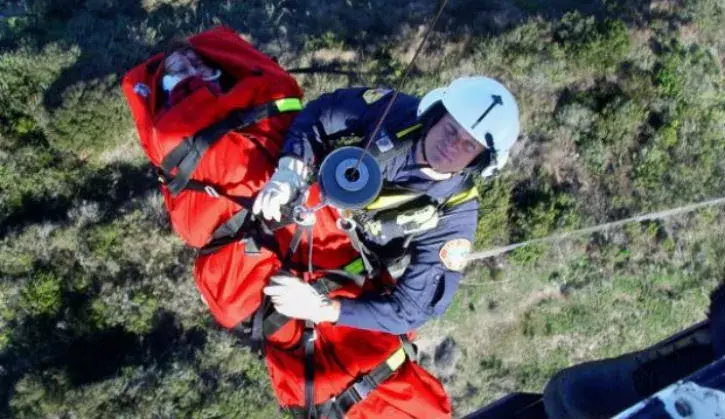The Department of Homeland Security (DHS) Science and Technology Directorate’s (S&T) First Responders Group (FRG) relies on experienced emergency response and preparedness professionals to guide its research and development efforts. The First Responder Resource Group (FRRG) fills that role. An all-volunteer working group, the FRRG helps S&T maintain focus on the top-priority needs of responders in the field. This series highlights several FRRG members, offering a glimpse into their daily responsibilities, as well as their ongoing support of S&T technology development.
 Meet Steve Vandewalle, paramedic and firefighter for the San Diego Fire Department (SDFD). Vandewalle’s participation in recent field tests for FRG’s Improved Structure Firefighting Glove was instrumental to the project’s progress, and we were curious about how this protective equipment might enhance his daily performance. We asked about his work, which involves wearing many hats, and about his personal experiences as an FRRG member.
Meet Steve Vandewalle, paramedic and firefighter for the San Diego Fire Department (SDFD). Vandewalle’s participation in recent field tests for FRG’s Improved Structure Firefighting Glove was instrumental to the project’s progress, and we were curious about how this protective equipment might enhance his daily performance. We asked about his work, which involves wearing many hats, and about his personal experiences as an FRRG member.
Vandewalle first became a paramedic in 1987, before SDFD had initiated its Air Operations Division. In time, the department identified a need to deliver pre-hospital care to patients in hazardous situations, including cliff or water rescues, U.S. Coast Guard and SWAT team responses. This soon led to one of his current roles as a helicopter rescue medic.
“Aerial firefighting, both day and night, is very important in a city and county like San Diego, since nearly every neighborhood is surrounded by dry hills and canyons,” Vandewalle said.
“I do a lot of hoist rescue work (via a cable mounted on a helicopter), removing patients in difficult positions where standard ground vehicles will have limited access,” he continued. “After reaching a patient and providing advanced life support, the patient and I are extracted together via the hoist to a waiting ambulance or transported directly to the hospital. We take off, perform a rescue, and deliver the patient straight to the trauma unit without ever landing in between. With San Diego's extensive back country, waterways, cliffs and canyons, SDFD’s two advanced life support helicopters are important resources.”
Vandewalle is also a member of the department’s Hazardous Materials Response Team, a collaboration between SDFD and the San Diego County Department of Environmental Health. In addition, he serves as a member of the Mobile Operational Detail (MOD), which transports first responders to emergency incidents quickly, particularly useful in crowded situations in the heart of the city.
“Marathons and special event crowds downtown are a challenge for responders—lots of people means lots of incidents, and getting a large fire apparatus through is difficult at best,” Vandewalle said. “Two people with limited gear aboard a bicycle or electric scooter can traverse a crowd much more effectively, streamline access for others and call for more resources or cancel incoming ones as the need dictates.”
 If Vandewalle’s plate is not full enough, he is also a technical information specialist for California Task Force 8, an elite team of specialists in urban search and rescue, disaster recovery and emergency triage and medicine that are deployed to emergency and disaster sites. Finally, he is also an Army National Guard helicopter manager for large scale fires.
If Vandewalle’s plate is not full enough, he is also a technical information specialist for California Task Force 8, an elite team of specialists in urban search and rescue, disaster recovery and emergency triage and medicine that are deployed to emergency and disaster sites. Finally, he is also an Army National Guard helicopter manager for large scale fires.
His training and expertise across several areas of emergency response made Vandewalle a natural candidate to join the FRRG as one of the group’s 120 nationwide subject matter experts (SME). He is well aware of the resources responders need to remain safe and effective, as well as the capabilities they currently lack. An FRRG member since 2008, he provided feedback on the Improved Structure Firefighting Glove beginning with the initial prototype developed in 2012, through the April 2014 field assessment outside of Chicago.
“Typically, people see technology as something that requires batteries. But, a conference call [with West Coast FRRG members] was very fruitful in identifying a number of capability gaps; one of which was just improving existing structure firefighting gloves,” Vandewalle explained.
“When a firefighter removes his or her glove to feel the door for heat before entering a burning structure and then has to put the glove back on, it causes a significant delay. Also, a sweaty hand does not slide in easily. A wet glove makes it even harder [to get the glove back on]. If the liner pulls inside out, a firefighter is likely to just make entry with a partially donned glove. In training, people routinely remove gloves for simple tasks like changing radio channels or using keys — transferring that habit to an actual fire ground will easily result in a career-ending hand burn. It’s not so much a failure of the glove, but a failure to wear gloves that diminish dexterity too much.”
“I wanted a glove that was easy to put on, even with wet hands or a wet glove. One with improved dexterity that could be worn throughout a fire,” Vandewalle continued. “The initial responses from glove manufacturers did not provide much improvement. When we dug deeper, we found the real issue was not the glove, but the materials available. That led to matching an innovative material manufacturer with an experienced glove manufacturer, and the results were impressive in the field test.”
The Improved Structure Firefighting Glove recently received National Fire Protection Association certification and should be available for commercial purchase by January 2015.
“A dexterous glove that is easy to put on and take off, even with wet hands, may not sound like 'cutting edge technology,' but it is amazing how much goes into a glove,” Vandewalle said. “I was invited to help evaluate the new glove and it is really a superior product.”
Most of Vandewalle’s involvement with the FRRG has been as a SME, rating the need for identified capability gaps, and he enjoys the work.
“As an FRRG member, the most satisfying event for me was the West Coast conference call — after a few hours of talking with a group of fire chiefs, we identified quite a few gaps with merit. I am currently working to evaluate the FRG Base Ensemble project to provide a day-to-day uniform for all responder disciplines that will offer an enhanced level of protection. It seems like an impossible task, which makes it pretty exciting.”
“When you consider the very narrow margin of what we can provide — facilitating a new technology for a real need that is both within the realm of possibility, does not already exist, and that will make its way through the budgets of targeted departments — it’s a pretty tall order,” Vandewalle said. “The FRRG has exposed me quite a bit to how the whole process works from identifying a need, matching it to a technology and finding a company that can bring it to fruition, while providing input along the way.”
Check back soon for additional FRRG member spotlights. For more information on how to become a member of the FRRG, contact first.responder@hq.dhs.gov.
